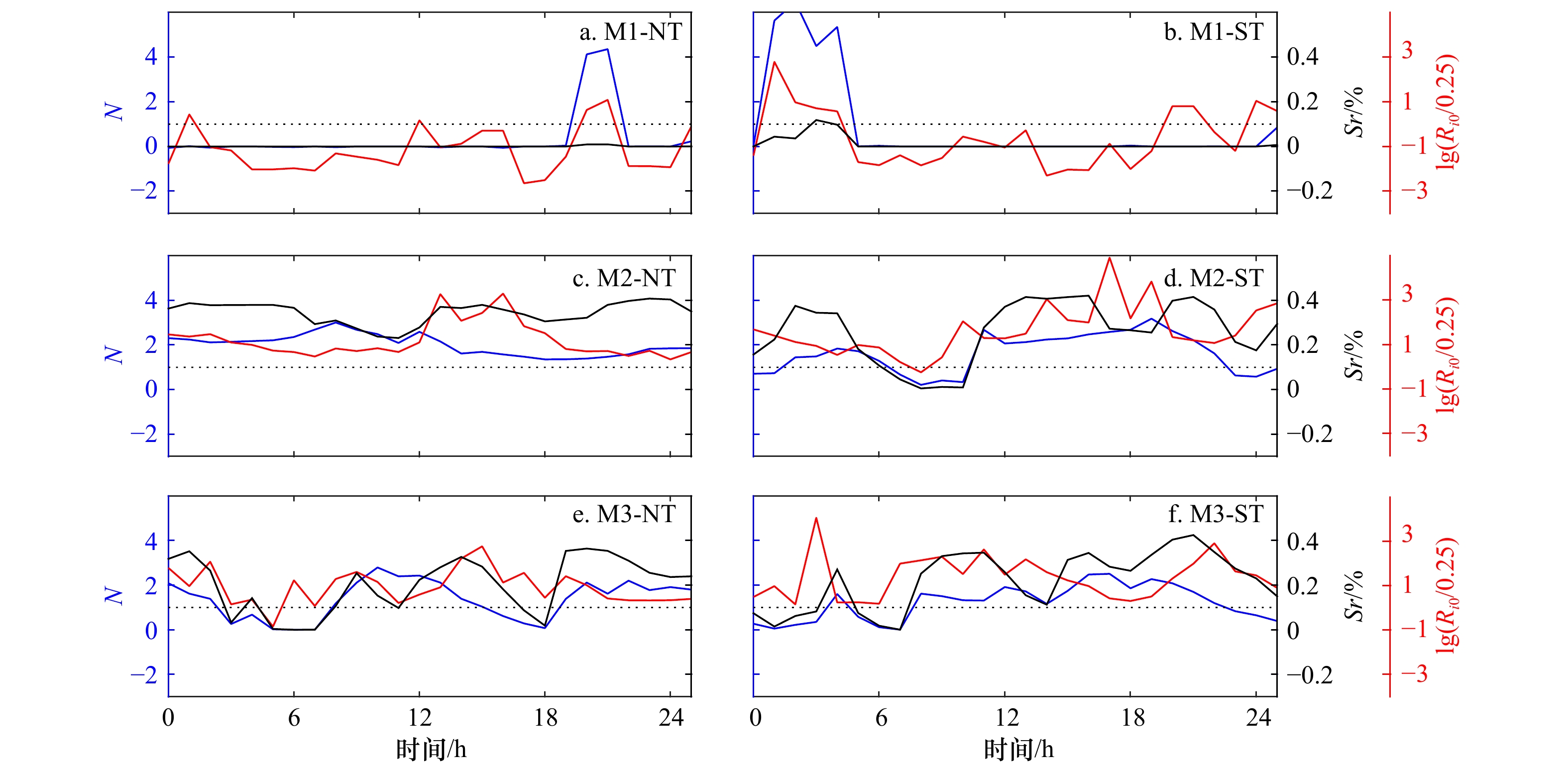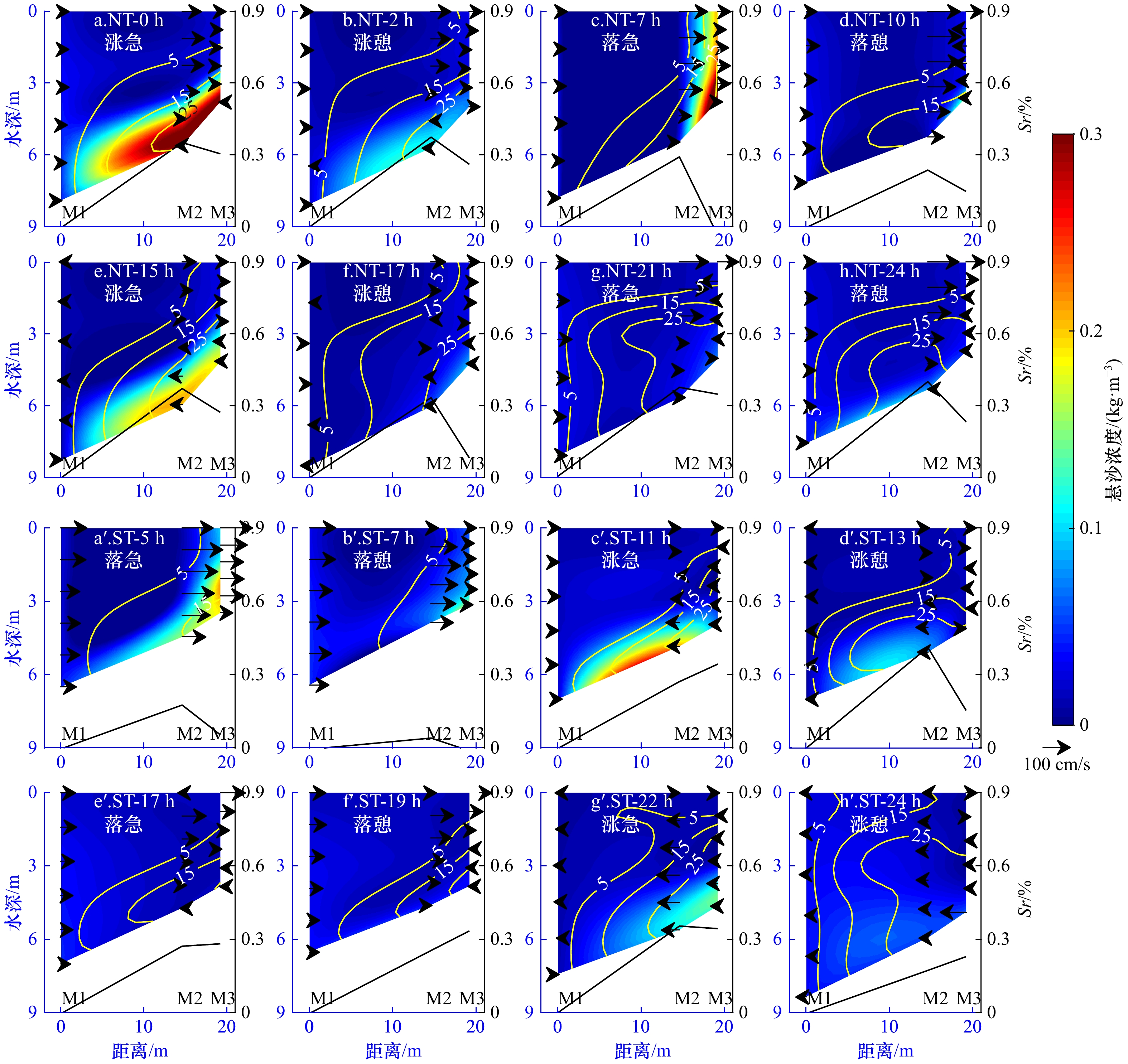Sediment trapping mechanism by salinity stratification in a river-dominted estuary: A case study of the Modaomen Estuary in flood season
-
摘要: 河控型河口盐度混合和层化是控制悬沙输移扩散的重要动力机制。以珠江磨刀门河口为研究对象,基于2017年洪季三船同步大、小潮水文泥沙观测数据,分析河控型河口水体盐度层化结构的时空变化对悬沙分布的影响机制。结果表明:受径潮动力耦合时空变化影响,河口盐度垂向分布表现出时空差异,即受径流主导的M1站(挂锭角),河口盐度在涨落潮周期内垂向混合均匀,受径潮控制的M2站(口门)在整个潮周期内盐度层化结构明显,口门外侧的M3站,潮动力作用较强,盐度垂向分布随涨落潮变化而变化;悬沙空间分布与盐度分布关系密切,盐度混合均匀利于悬沙垂向均匀分布,而盐度层化则使悬沙倾向于滞留在底层水体中,且在盐度层结界面之下出现高悬沙浓度,悬沙浓度垂向分布曲线呈L字型或抛线型,纵向上表现为高浓度悬沙团抑制在盐水楔前端,盐度层化对悬沙的捕集效应明显。通过对比水体标准化分层系数与水流垂向扩散强度系数发现,两者呈现负相关关系,即标准化分层系数愈大,垂向扩散强度愈小,表明水体层化抑制悬沙垂向扩散强度,而且水体层化程度越高,悬沙垂向扩散抑制程度越大,进而促进了河口水体盐度层化对悬沙捕集作用。本研究有助于揭示河口细颗粒泥沙运动机制及河口拦门沙演变机制,并为磨刀门河口拦门沙治理提供科学依据。Abstract: Salinity mixing and stratification in the river-dominated estuaries are important dynamic mechanisms for controlling transport and diffusion of suspended sediment. Based on the synchronous field investigation with three surveying vessels in the flood season in 2017, covering the spring and neap tidal cycles, the influence mechanism of salinity stratification on suspended sediment distribution in the Modaomen Estuary was analyzed in this study. Vertical distribution of salinity in the estuary also displayed spatial differences under the influence of interaction between riverine and tidal dynamics. The salinity at M1 Station (Guading Jiao), dominated by runoff, was mixed well vertically over the tidal cycles; salinity stratification occurred at the M2 Station (outlet location) and at M3 Station (outside the mouth), which were influenced by interaction between runoff and tide over the tidal cycles. Spatial distribution of suspended sediment was closely related to spatial distribution of salinity. In general, salinity mixing promoted the vertical mixing of suspended sediment, while salinity stratification constrained the suspended sediment to be concentrated in the bottom water layer, and high suspended sediment concentration (SSC) tended to appear at the layer where salinity stratified occur. The vertical distribution curve of SSC was L-shape or paracurve shape, while high SSC always concentrated in the front of the salinity wedge in the longitudinal direction, indicating a significant sediment trapping effect caused by salinity stratification. Comparing the stratification ratio and vertical diffusion coefficient at three gauging stations, there was a negative relationship between them, the larger stratification ratio is, the smaller vertical diffusion coefficient is, indicating the suppression effect of stratification on vertical diffusion. Furthermore, the higher stratification is, the larger suppression effect is. Such mechanism contributes to the sediment trapping caused by stratification. This study is helpful to reveal the mechanism of fine sediment movement and the mechanism of evolution of mouth bar in a complicated estuary, and provide scientific basis for regulation of mouth bar in the Modaomen Estuary.
-
图 4 磨刀门河口M1、M2和M3站小潮(NT)和大潮(ST)期间悬沙浓度时间过程图(横轴0点为观测周期起点时刻,白色线为盐度等值线)
Fig. 4 Time series of suspended sediment concentration profiles at the M1 Station, M2 Station and M3 Station in the Modaomen Estuary during neap tide (NT) and spring tide (ST) (point 0 on the horizontal axis is the starting time of the observation period, the white lines indicate the salinity contour lines)
图 5 磨刀门河口M1、M2和M3站小潮(NT)和大潮(ST)期间分层系数(N,蓝色线)、标准化分层系数(Sr,黑色线)和总体Richardson数(Ri0,红色线)时间过程图
横轴0点为观测周期起点时刻,虚线为3个参数的层化临界值:N=1、Sr=0.1%以及lg(Ri0 /0.25) =0,即Ri0 =0.25
Fig. 5 Time series of the stratification ratio (N, blue lines), the normalized stratification ratio (Sr, black lines) and the overall Richardson number (Ri0, red lines) profiles at the M1 Station, M2 Station and M3 Station in the Modaomen Estuary during neap tide (NT) and spring tide (ST)
Point 0 on the horizontal axis is the starting time of the observation period. The dotted lines indicate the stratification critical values of three parameters: N=1, Sr=0.1%, and lg (Ri0/0.25) =0, i.e., Ri0 =0.25
图 7 磨刀门河口M1,M2和M3站小潮(NT)和大潮(ST)特征时刻各水层悬沙浓度离散系数(CV,蓝色线)和标准化分层系数(Sr,黑色线)
Fig. 7 Time series of the coefficient of variation of suspended sediment concentration (CV, blue lines) and the normalized stratification ratio (Sr, black lines) profiles at the M1 Station, M2 Station and M3 Station in the Modaomen Estuary during the characteristic moments of neap tide (NT) and spring tide (ST)
图 8 小潮(NT)和大潮(ST)特征时刻纵向盐度、悬沙浓度分布
黄色线为盐度等值线,黑色线为标准化分层系数Sr,黑色箭头为流速,箭头方向向右为径流方向
Fig. 8 Longitudinal distribution of salinity and suspended sediment concentration during the characteristic moments of neap tide (NT) and spring tide (ST)
The yellow lines are the contour lines of salinity. The black lines are the standardized stratification ratio Sr. The black arrows are the velocity, and the arrow to the right indicates the direction of runoff
图 9 磨刀门河口M1,M2和M3站小潮(NT)、大潮(ST)标准化分层系数Sr和垂向扩散系数 Kz 的散点分布(蓝色圈)和线性拟合曲线(红色线)
Fig. 9 Scatter distribution (blue circle) and linear fitting curve (red line) of standardized stratification coefficient (Sr) and vertical diffusion coefficient (Kz) at the M1 Station, M2 Station and M3 Station in the Modaomen Estuary during the neap tide (NT) and spring tide (ST)
-
[1] Milliman J D, Syvitski J P M. Geomorphic/tectonic control of sediment discharge to the ocean: the importance of small mountainous rivers[J]. The Journal of Geology, 1992, 100: 525−544. doi: 10.1086/629606 [2] Simpson J H, Brown J, Matthews J, et al. Tidal straining, density currents, and stirring in the control of estuarine stratification[J]. Estuaries, 1990, 13(2): 125−132. doi: 10.2307/1351581 [3] Chou Yiju, Nelson K S, Holleman R C, et al. Three-dimensional modeling of fine sediment transport by waves and currents in a shallow estuary[J]. Journal of Geophysical Research: Oceans, 2018, 123(6): 4177−4199. doi: 10.1029/2017JC013064 [4] Zhang Guang, Cheng Weicong, Chen Lianghong, et al. Transport of riverine sediment from different outlets in the Pearl River Estuary during the wet season[J]. Marine Geology, 2019, 415: 105957. doi: 10.1016/j.margeo.2019.06.002 [5] 田枫, 欧素英, 杨昊, 等. 伶仃洋河口泥沙絮凝特征及影响因素研究[J]. 海洋学报, 2017, 39(3): 55−67.Tian Feng, Ou Suying, Yang Hao, et al. Study on the flocs characteristic and dynamics effects in the Lingdingyang Estuary[J]. Haiyang Xuebao, 2017, 39(3): 55−67. [6] 矫恒晨, 王盼盼, 简慧敏, 等. 长江口及邻近海域沉积物再悬浮对水体磷酸盐的影响的模拟研究[J]. 海洋学报, 2017, 39(4): 28−38.Jiao Hengchen, Wang Panpan, Jian Huimin, et al. Simulation study of the effects of sediment resuspension on phosphate loading in the Changjiang Estuary and its adjacent area[J]. Haiyang Xuebao, 2017, 39(4): 28−38. [7] 孙继涛, 张庆河, 严冰, 等. 盐度层化对长江口水动力的影响[J]. 水道港口, 2015, 36(2): 93−104. doi: 10.3969/j.issn.1005-8443.2015.02.001Sun Jitao, Zhang Qinghe, Yan Bing, et al. Effects of salinity stratification on hydrodynamics in the Yangtze River Estuary[J]. Journal of Waterway and Harbor, 2015, 36(2): 93−104. doi: 10.3969/j.issn.1005-8443.2015.02.001 [8] 黄睿, 张庆河, 邢恩博, 等. 盐度层化对水体紊动特性影响的实验研究[J]. 水力发电学报, 2020, 39(3): 45−55.Huang Rui, Zhang Qinghe, Xing Enbo, et al. Experimental investigation on effects of salinity stratification on turbulence characteristics of water body[J]. Journal of Hydroelectric Engineering, 2020, 39(3): 45−55. [9] Geyer W R. The importance of suppression of turbulence by stratification on the estuarine turbidity maximum[J]. Estuaries, 1993, 16(1): 113−125. doi: 10.2307/1352769 [10] Pritchard D W. Estuarine circulation patterns[M]//Washington D C: Proceedings of the American Society of Civil Engineers, 1955, 81: 1−11. [11] Li Li, He Zhiguo, Xia Yuezhang, et al. Dynamics of sediment transport and stratification in Changjiang River Estuary, China[J]. Estuarine, Coastal and Shelf Science, 2018, 213: 1−17. doi: 10.1016/j.ecss.2018.08.002 [12] Li Xiangyu, Zhu Jianrong, Yuan Rui, et al. Sediment trapping in the Changjiang Estuary: observations in the north passage over a spring-neap tidal cycle[J]. Estuarine, Coastal and Shelf Science, 2016, 177: 8−19. doi: 10.1016/j.ecss.2016.05.004 [13] Wu Jiaxue, Liu J T, Wang Xia. Sediment trapping of turbidity maxima in the Changjiang Estuary[J]. Marine Geology, 2012, 303: 14−25. doi: 10.1016/j.margeo.2012.02.011 [14] Xiao Yang, Wu Zheng, Cai Huayang, et al. Suspended sediment dynamics in a well-mixed estuary: the role of high suspended sediment concentration (SSC) from the adjacent sea area[J]. Estuarine, Coastal and Shelf Science, 2018, 209: 191−204. doi: 10.1016/j.ecss.2018.05.018 [15] 王世俊, 易小兵, 李春初. 磨刀门河口水沙变化与地貌响应[J]. 海洋工程, 2008, 26(3): 51−57. doi: 10.3969/j.issn.1005-9865.2008.03.009Wang Shijun, Yi Xiaobing, Li Chunchu. Variation of flow and sediment and response of morphology in Modaomen Estuary of Xijiang River[J]. The Ocean Engineering, 2008, 26(3): 51−57. doi: 10.3969/j.issn.1005-9865.2008.03.009 [16] Tan Chao, Huang Bensheng, Liu Feng, et al. Recent morphological changes of the mouth bar in the Modaomen Estuary of the Pearl River Delta: Causes and environmental implications[J]. Ocean & Coastal Management, 2019, 181: 104896. [17] 胡达, 李春初, 王世俊. 磨刀门河口拦门沙演变规律的研究[J]. 泥沙研究, 2005, 4: 71−75. doi: 10.3321/j.issn:0468-155X.2005.04.012Hu Da, Li Chunchu, Wang Shijun. Study on evolutional processes of the sand bar in Modaomen Estuary[J]. Journal of Sediment Research, 2005, 4: 71−75. doi: 10.3321/j.issn:0468-155X.2005.04.012 [18] 欧素英, 田枫, 郭晓娟, 等. 珠江三角洲径潮相互作用下潮能的传播和衰减[J]. 海洋学报, 2016, 38(12): 1−10.Ou Suying, Tian Feng, Guo Xiaojuan, et al. Propagation and damping of tidal energy in the Pearl River Delta[J]. Haiyang Xuebao, 2016, 38(12): 1−10. [19] 任杰, 刘宏坤, 贾良文, 等. 磨刀门水道盐度混合层化机制[J]. 水科学进展, 2012, 23(5): 715−720.Ren Jie, Liu Hongkun, Jia Liangwen, et al. Research on salinity mixing and stratification mechanisms at the Modaomen channel[J]. Advances in Water Science, 2012, 23(5): 715−720. [20] 吕紫君, 冯佳佳, 郜新宇, 等. 磨刀门河口环流与咸淡水混合层化机制[J]. 水科学进展, 2017, 28(6): 908−917.Lü Zijun, Feng Jiajia, Gao Xinyu, et al. Estuarine circulation and mechanism of mixing and stratification in the Modaomen Estuary[J]. Advances in Water Science, 2017, 28(6): 908−917. [21] 梁娟, 李春初. 人类活动影响下磨刀门河口的泥沙输运沉积[J]. 泥沙研究, 2010, 3: 67−72.Liang Juan, Li Chunchu. Tendency of sediment transport and sedimentation in the Modaomen Estuary under influence of human activities[J]. Journal of Sediment Research, 2010, 3: 67−72. [22] 林凤标, 郑国栋, 刘壮添. 磨刀门水道近50年河床演变及其冲淤成因分析[J]. 泥沙研究, 2017, 42(3): 48−53.Lin Fengbiao, Zheng Guodong, Liu Zhuangtian. Evolution and causes of the Modaomen River during the last 50 years[J]. Journal of Sediment Research, 2017, 42(3): 48−53. [23] 中华人民共和国水利部. 中国河流泥沙公报(2017)[M]. 北京: 中国水利水电出版社, 2018: 45.Ministry of Water Resources of the People's Republic of China. Zhongguo Heliu Nisha Gongbao (2017)[M]. Beijing: China Water & Power Press, 2018: 45. [24] 广东省水利电力勘测设计研究院. 珠江河口整治近期防洪实施工程可行性研究报告[R]. 广州: 广东省水利电力勘测设计研究院, 2002.Guangdong Water Conservancy and Electric Power Survey and Design Institute. Feasibility study report on the recent flood control project of the Pearl River Estuary[R]. Guangzhou: Guangdong Water Conservancy and Electric Power Survey and Design Institute, 2002. [25] 贾良文, 吕晓莹, 程聪, 等. 珠江口磨刀门月际尺度地貌演变研究[J]. 海洋学报, 2018, 40(9): 65−77.Jia Liangwen, Lü Xiaoying, Cheng Cong, et al. Study on the morphological evolution of the Modaomen Estuary in monthly scale[J]. Haiyang Xuebao, 2018, 40(9): 65−77. [26] Stacey M T, Rippeth T P, Nash J D. Turbulence and stratification in estuaries and coastal seas[J]. Treatise on Estuarine and Coastal Science, 2011, 2: 9−35. [27] Geyer W R, MacCready P. The estuarine circulation[J]. Annual Review of Fluid Mechanics, 2014, 46: 175−197. doi: 10.1146/annurev-fluid-010313-141302 [28] Pu Xiang, Shi J Z, Hu Guodong, et al. Circulation and mixing along the north passage in the Changjiang River Estuary, China[J]. Journal of Marine Systems, 2015, 148: 213−235. doi: 10.1016/j.jmarsys.2015.03.009 [29] Bowden K F. Turbulent mixing in estuaries[J]. Ocean Management, 1981, 6(2/3): 117−135. [30] Simpson J H, Williams E, Brasseur L H, et al. The impact of tidal straining on the cycle of turbulence in a partially stratified estuary[J]. Continental Shelf Research, 2005, 25(1): 51−64. doi: 10.1016/j.csr.2004.08.003 [31] Cameron W M, Pritchard D W. Estuaries[M]//Hill M N. The Sea, vol 2. New York: John Wiley and Sons, 1963: 306−324. [32] Simpson J H, Allen C M, Morris N C G. Fronts on the continental shelf[J]. Journal of Geophysical Research: Oceans, 1978, 83(C9): 4607−4614. doi: 10.1029/JC083iC09p04607 [33] Simpson J H, Bowers D. Models of stratification and frontal movement in shelf seas[J]. Deep−Sea Research Part A: Oceanographic Research Papers, 1981, 28(7): 727−738. doi: 10.1016/0198-0149(81)90132-1 [34] Mehta A J. On estuarine cohesive sediment suspension behavior[J]. Journal of Geophysical Research: Oceans, 1989, 94(C10): 14303−14314. doi: 10.1029/JC094iC10p14303 [35] Officer C B. Physical Oceanography of Estuaries (and Associated Coastal Waters)[M]. New York: Wiley, 1976: 209−218. -





 下载:
下载:








